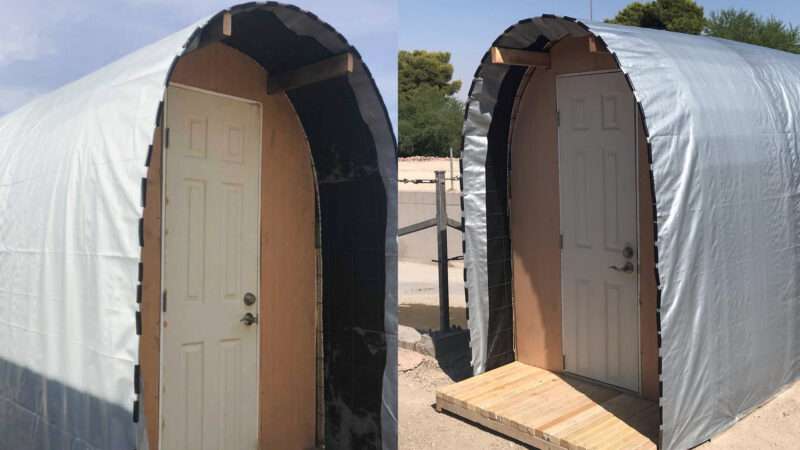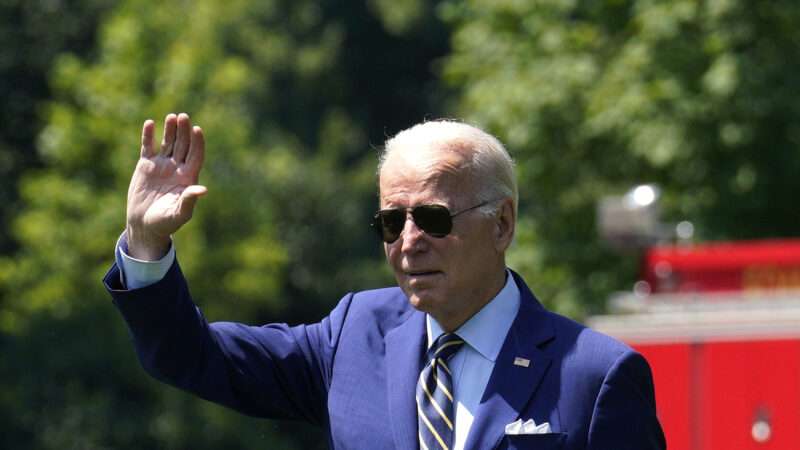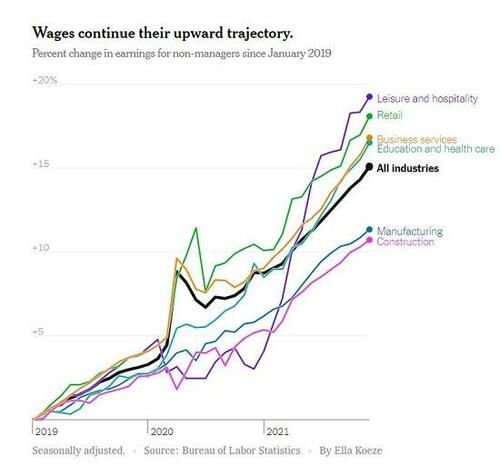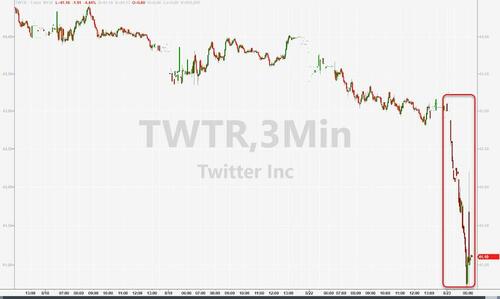
Homeless shelters destroyed “to ensure the safety and welfare” of homeless people. North Las Vegas authorities demolished a community of tiny homes that sheltered the homeless because the 50-square-foot structures didn’t meet the minimum home size required by law or conform to other strict housing regulations. The situation showcases how government often thwarts private solutions to homelessness and poverty.
The tiny homes were built on private property owned by the nonprofit New Leaf Building Community. New Leaf’s structures are small and basic, featuring four walls, one window, and a front door that locks. But despite their small size and lack of amenities, they could be life-changing for people previously living on the streets.
“Now I sleep on the damn sidewalk because of this!” a man who had been living in a New Leaf home told KTNV Las Vegas. A woman named Angela said her New Leaf home made her feel “like, yes, I can do this. I can stay clean and sober. I can create. Draw. I can become anything I want to be at that moment.”
The New Leaf homes were built on private land by volunteers. The idea was to provide homeless people with “a place to call home,” said New Leaf leader Joseph Lankowski. “They had a tiny home where they could lock the door, so then they could actually go out and get services without having to worry about getting your things stolen or anything like that.”
Lankowski raised funds to buy the land after other options failed. In November 2020, the government destroyed 28 tiny homes New Leaf built on public land that had for years housed a homeless encampment. New Leaf then tried building tiny homes on trailers that could be parked in public parking spaces, but police started towing these. “And because their whole argument was property, you know, ‘This is our property. It’s not your property.’ And we said, ‘Okay. We’ll buy our own property,'” he told KNTV.
The North Las Vegas land Lankowski built on is zoned for single-family homes, which must be a minimum size of 1,200 square feet. But because there was no existing zoning for this type of project, Lankowski decided to build first and deal with bureaucracy later.
“If code enforcement’s whole premise is safety, what’s safer?” he asked. “Being in a tiny home on private property or being out on the streets?”
A bill passed by Nevada in 2021—SB 150—says large cities and counties must legalize tiny home communities by creating new building and zoning rules that pertain to them. But these rules needn’t be in place until 2024.
“Our homelessness crisis is urgent and can not wait for ‘codes’ to catch up,” New Leaf posted on Instagram in July. The post said “the city of North Las Vegas did not give us due process before bulldozing.  They are not playing by their own rules. This is private property. ”
They are not playing by their own rules. This is private property. ”
The city said New Leaf housing was in violation of Uniform Housing Code and Municipal Code regulations. “Since December 2021, the City has attempted to work with the property owner to correct violations on the property,” it said in a statement to KTNV. “Rather than correct the violations, the property owner increased the pace of non-permitted construction and brought individuals to live on the property without access to fresh water, heating, cooling or adequate sewage disposal, all of which are required by SB150.”
“On multiple occasions, the City served formal notices of violations and abatement on the property and issued civil and criminal citations to the property owner,” the city added. “The owner never completed any appeals within the timeframes outlined in the various notices.”
The Nevada Department of Transportation told KTNV:
“The decision to pursue this abatement was intended to ensure the safety and welfare of both the homeless and surrounding community due to significant biohazard concerns, including bodily waste, debris and intravenous drug paraphernalia accumulating inside drainage channels that feed into the Las Vegas Wash. Other concerns included potential pedestrian-vehicle hazards from crossing the interstate, walking alongside the shoulder and/or encamping within the Union Pacific Railroad corridor, as well as obstructed driver sightlines.”
Lankowski said that New Leaf had been working to fix or appeal any violations.
“We had first aid kits. We had water. They were going to install showers,” Angela, one of the residents, told KTNV.
The situation raises questions about the ethical housing of the homeless. Some—including the city of North Las Vegas, apparently—say it’s wrong to build the homeless tiny shelters that don’t contain things like indoor plumbing, heat, or air conditioning. But is some protection from the elements better than none at all? Doesn’t having a dedicated place to sleep and store possessions matter, even if that’s all it is?
The government seems to be making the perfect the enemy of the good here.
Alas, North Las Vegas isn’t alone in seizing or destroying tiny homes built to house homeless people. City officials in Los Angeles and Denver have engaged in similar crackdowns.
Zoning rules have also been used to stop the building of homeless shelters around the country, and to prevent churches from providing beds to the homeless. Meanwhile, city attempts to build new housing for the homeless are often slow, ridiculously expensive, and inadequate.
For what it’s worth, New Leaf seems to still be building. “We can’t be stopped!” it posted to Instagram last week, in a call for volunteers to help build more tiny homes.
FOLLOWUP
Trump sues over seized documents. Former President Donald Trump is asking a judge to appoint a special master to review the documents the Justice Department seized from his Mar-a-Lago club. As part of the lawsuit, filed Monday, Trump “asked a judge to order investigators to immediately stop examining the items,” reports the Wall Street Journal. “A special master is a third party, usually a retired judge, who reviews evidence to determine whether it is protected by attorney-client privilege, executive privilege, or similar legal doctrines.”
“The government has recovered more than 300 documents with classified markings from Mr. Trump since he left office,” notes The New York Times. This includes more than 150 documents he returned to the National Archives in January and documents seized by the FBI in a recent raid.
FREE MINDS
The power of projection? People vote for democracy-destroying measures because they’re afraid “their opponents will dismantle democracy first,” according to new research. In the U.S., “partisans who most fear the other party’s willingness to subvert democracy are also those most willing to support subverting democracy.” In an experimental environment, the researchers performed interventions meant to reduce these fears; their findings suggest that with reduced fears of the other party, people “become more committed to upholding democratic norms” and “may also become more willing to vote against candidates of their own party who break these norms.” You can find the full pre-print study (“The Subversion Dilemma: Why Voters Who Cherish Democracy Participate in Democratic Backsliding”) here.
FREE MARKETS
Ireland gets a lesson in unintended consequences:
Ireland launched a campaign against greedy landlords with rent control, 52% tax, no deductions, no evictions.
They succeeded & landlords left the market in droves
Now there are 716 homes available to rent in the entire country and 150 queued for this one bed yesterday. #VanRe pic.twitter.com/T8Np0hjthB
— Conor ???????? (@conorsvan1) August 18, 2022
QUICK HITS
• The White House is reportedly getting closer to canceling some student loan debt.
• Pfizer is asking the Food and Drug Administration to authorize a COVID-19 booster vaccine that specifically targets omicron subvariants.
• Even stricter restrictions on abortion are set to take effect this week in Texas, Tennessee, and Idaho.
• Liz Truss—a limited government conservative who is friendly to free markets—looks poised to become Britain’s next prime minister, writes Dan Hannan at the Washington Examiner.
• California Democratic Gov. Gavin Newsom has vetoed legislation that would have allowed some cities to operate safe injection sites, where people could use drugs in a supervised manner, with medical professionals around to help prevent fatal overdose. (San Francisco says it will do it anyway.)
Gov. Newsom vetoed our legislation to authorize SF, Oakland & LA to implement safe consumption sites.
The veto is tragic & a huge lost opportunity. These sites are proven to save lives & connect people to treatment. Sad day for CA’s fight against overdose deaths.
My statement: pic.twitter.com/YYrnZTlEss
— Senator Scott Wiener (@Scott_Wiener) August 22, 2022
• An anti-drug group has filed a lawsuit trying to stop Missourians from voting on whether to legalize recreational marijuana.
• Efforts to get marijuana on the ballot in Nevada have failed.
• Zvi Mowshowitz looks at a paper on car seats and fertility rates and argues that America should eliminate car seat requirements for older children.
• Americans increasingly see political polarization overtaking public education—and that’s why we need school choice now, writes Reason‘s J.D. Tucille.
• “Would you believe the American Civil Liberties Union (ACLU) and Republican Florida Gov. Ron DeSantis have something in common?” asks Reason‘s Scott Shackford. “They both believe that the state should be able to force web companies to host content that these platforms disagree with or find morally objectionable in some fashion.”
The post Tiny Homes for Las Vegas Homeless Demolished Over Code Violations appeared first on Reason.com.
from Latest https://ift.tt/BxC8Smy
via IFTTT






